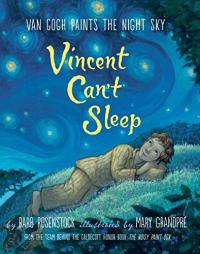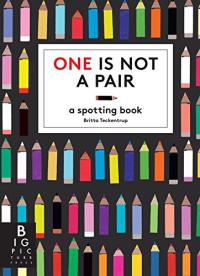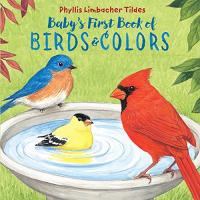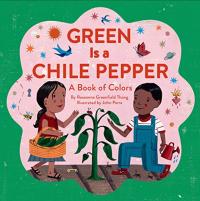
If your finger is placed on the small blue dot, say “oh.” If it’s on a big blue dot, say “OH!” Imagine what happens when there is a series of blue dots! Blue, red, and yellow lines and dots dance across white pages encouraging sounds and gleeful play in this inventive participatory book.
Say Zoop!

Vincent Van Gogh often had trouble sleeping. As a child, his parents fussed but Vincent continued to travel in his imagination, which precluded sleep. Glowing illustrations suggest the artist’s style and a rhythmic text provides an engaging introduction to Van Gogh and his powerful paintings. An author’s note includes additional information as well as images of several of Van Gogh’s paintings.
Vincent Can’t Sleep

The world of Islam is intrduced by describing its colors and traditions in simple rhymes. From a red prayer rug to a blue hijab, everyday colors are given special meaning as young readers learn about clothing, food, and other important elements of Islamic culture, with a young Muslim girl as a guide. Terms introduced are explained in greater detail in the book’s end.
Golden Domes and Silver Lanterns: A Muslim Book of Colors

Can you find the ice cream cones that look alike? How about the tractors? Can you spot the leaves that are the same? It’s not as easy as it looks! Poems ask readers to identify the pair on the opposing page from among similar, clear but tough-to-tell-apart illustrations in this playful book that requires a keen eye!
One Is Not a Pair: A Spotting Book

Ruby builds with her red blocks while Benji uses his blue blocks. An argument erupts when Benji tries to take one of the red blocks. Tugging and pulling makes a mixed up mess of blue and red blocks that creates cooperative construction! What will happen when Guy joins them with green blocks? Uncluttered illustrations and straightforward text present the recognizable tale.
Blocks

Observing birds and eating berries just may lead to a summertime exploration of colors and counting. Meet the yellow goldfinch, a pink flamingo, and other well and less familiar birds in brief text and realistic illustrations. In The Very Berry Counting Book (opens in a new window) by Jerry Pallotta (Charlesbridge; 1580897843), you can count realistic, luscious looking berries from 1 to 10.
Baby’s First Book of Birds and Color

As a cat walked through the world, “with its whiskers, ears, and paws…” a child, a mouse, a dog, and others see the cat — each from its own unique perspective. The mouse sees all claws and teeth, the worm sees echoes in the ground, and so on. The repeating refrain combines with original and stunning illustrations to create a book to examine multiple times.
They All Saw a Cat

Who did what? What did they do? Where did they do it? A question is asked on each horizontal page; the answer is on the next page – but a keen eye is needed to figure it out by looking carefully at a line-up of suspects. The characters are comical in recognizable situations. (Happily, a key to the right answers appears at the very end.)
Who What Where?

White Cat lives in a black home while Black Cat lives in a white one. They disappear when they visit the other, but find a colorful answer to their dilemma. High contrast illustrations on sturdy pages hold enough interest for both children and the adults reading with them.
Black Cat and White Cat

Superheroes in brightly colored uniforms are used to introduce young children to colors. The green Hulk wears “purple pants” while Captain America sports “white stars.”
Mighty Colors

Why would it be cancelled? What villain has added the red scribble to the picture book stage? With tongue in cheek, the author presents another humorous look at the life and interactions of crayons, this time riffing on old horror movies. Bold crayon characters (and scribbles) appear on open pages with varied typeface.
Frankencrayon

What do circles and die-cuts on a red page have to do with apples? Find out with a page turn to see apples followed by other shapes, bright colors, and cut-outs for a surprising, delightful, and highly imaginative jaunt in a simple yet surprisingly sophisticated presentation.
Apples and Robins

A rhyming description of a host of animals combines with crisp, colorful, and detailed illustrations encouraging readers to find matching pairs. Careful examination is needed to discern the differences in identically shaped but uniquely colored critters in this attractive game book.
Where’s the Pair? A Spotting Book

Crisp color photographs of fruits and vegetables are presented. One of each is presented on the left of the double page spreads, while variations of the fruit or veggie (e.g., there are 12 different citrus fruits) are introduced on the opposing page. There is potential to introduce new edibles — perhaps at your local farmer’s market — while counting and playing with numbers.
Edible Numbers

Many animals on land and in the water, familiar and exotic, have spots — seen here through brief, poetic language and carefully crafted illustrations: “Spots with purpose, spots with flair. Spotted creatures everywhere!” Additional information about the animals and where they live concludes this handsome informational book.
Spectacular Spots

Red is misunderstood. He’s a red crayon with a label that says blue so he can’t draw a strawberry or even a stoplight. But when Red learns that he’s really blue, well, he regains his self-confidence. Child-like drawings combine with precise collages for a memorable and humorous take on expectations, labels, and self-confidence.
Red: A Crayon’s Story

A word on one side is illustrated on the opposing page of each spread. Lift the sturdy flap, and the egg becomes a chick, the acorn becomes an oak tree, etc. Even a very familiar caterpillar becomes a handsome butterfly in this thoughtfully presented glimpse of spring things.
How Things Grow

“Goodness! Gracious! Yikes!” exclaim a timid group of carpenter ants as they peer out of holes made by one brave insect, viewing a rainbow of color. What they discover instead of an ant-eating, ketchup-carrying, orange aardvark with pack of green geckos will delight young readers as they see the vivid colors through die cuts and bold shapes in this satisfying, humorous tale.
It’s an Orange Aardvark!

A young artist brings color to a colorless city with her imaginative drawings of nonthreatening creatures. Though scolded by adults who wash color away, other kids have been inspired to continue. Humor abounds in the detailed line drawings as the girl and critters inspire others.
Monster Book

When a boy’s dragon goes missing in New York City, he goes out in search of it. Readers can explore the city sights while counting from one dragon to 20 lanterns. Illustrations use black line to create texture with color to define the objects counted.
Have You Seen My Dragon?

Each dramatic photograph of an animal (such as a pink flamingo) on a white background is accompanied by one word: its color. In Creature Numbers (opens in a new window), Animals from 1 to 10 bounce, swim, and pose on the equally open pages of a companion book for a fine, fun introduction to basic concepts.
Creature Colors

Die-cuts let readers ‘spy’ a portion of an animal while text provides clues as to what it might be. With the turn of the page the entire bird is portrayed. Basic characteristics and attractive illustrations provide an informative glimpse of a variety of fowl while playing a variant of a familiar game.
I Spy in the Sky

Colors introduce foods and more Mexico and other Spanish-speaking counties. Naïve style illustrations accompany bouncy rhymes that incorporate Spanish words; all colors appear in both Spanish and English.
Green Is a Chile Pepper

What can you see in shadows? A girl imagines she sees a crocodile and more — until the light returns with a click. Limited colors energetically depict her imagination. Her musings are reminiscent of shadow puppetry (and just may inspire creation of them, too).
